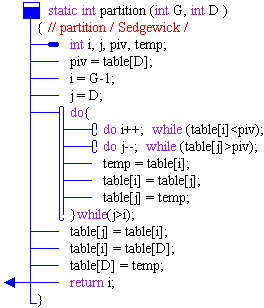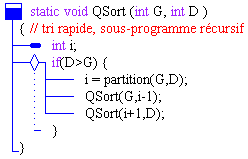Une classe
Java solution du problème :
Le sous programme Java implantant l'algorithme de tri rapide :
Une classe complète permettant l'exécution du sous-programme
précédent :
class ApplicationTriQSort {
static int[] table
= new int[21] ; // le tableau à
trier : 21 éléments |
static void AfficherTable
( ) {
// Affichage du tableau
sans les sentinelles
int
n = table.length-2;
for
(
int
i = 1; i <= n; i++)
System.out.print(table[i]+"
, ");
System.out.println();
}
static void InitTable
( ) {
// remplissage aléatoire
du tableau
int
n = table.length-2;
for
( int i = 1; i <= n; i++)
table[i]
= (int)(Math.random()*100);
table[0]
= -Integer.MAX_VALUE;
table[n+1]
= Integer.MAX_VALUE;
}
static void main(String[ ] args)
{
InitTable ( );
int n = table.length-2;
System.out.println("Tableau
initial :");
AfficherTable ( );
QSort(1,n);
System.out.println("Tableau
une fois trié :");
AfficherTable ( );
} |
static int partition (int G, int
D )
{
//
partition / Sedgewick /
int
i, j, piv, temp;
piv = table[D];
i = G-1;
j = D;
do
{
do i++;
while
(table[i]<piv);
do j--;
while
(table[j]>piv);
temp = table[i];
table[i] = table[j];
table[j] = temp;
}while(j>i);
table[j] = table[i];
table[i] = table[D];
table[D] = temp;
return
i;
}
static
void QSort (int G, int D )
{ //
tri rapide, sous-programme récursif
int
i;
if
(D>G) {
i = partition(G,D);
QSort(G,i-1);
QSort(i+1,D);
}
} |
} |
Image en diagrammes structurés JGrasp-Like du programme

informations sur les diagrammes
 Source
recopiable (cliquez sur le lien)
Source
recopiable (cliquez sur le lien)
Tableau initial :
68 , 2 , 61 , 81 , 2 , 27 , 10 , 79 , 5 , 70 , 33 , 72 , 38 , 49 ,
49 , 4 , 69 , 18 , 20
Tableau une fois trié :
2 , 2 , 4 , 5 , 10 , 18 , 20 , 27 , 33 , 38 , 49 , 49 , 61 , 68 , 69
, 70 , 72 , 79 , 81
Remonter 


![]()
![]() Source
recopiable (cliquez sur le lien)
Source
recopiable (cliquez sur le lien)